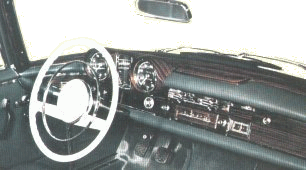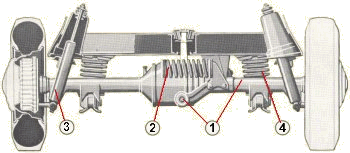| Back to the History of the Coupés and Convertibles |
|
|
|
 Here (a 300SE for example), the dashboard was also heavily padded and all the switches were made of flexible material. Although this time the instrument cluster wasn't padded because it was made of wood, later models did have a padded cluster. The steering wheel had a padded central horn ring and the rearview mirror was designed to come off its mounting under impact. All this was exactly the same as the sedan models. You could even find the same type of windscreen wipers: the arms of the wiper working in opposing directions and overlapping in the middle of the screen so that the vertical edge of the glass was almost fully cleared. |
 One of the factors of safety was the roadability achieved through the use of the (1) Swing axle with its low pivot point which keeps both rear wheels in constant contact with the road. (2) An extra Compensating Spring can be found on the 220SE Coupés and Convertibles providing additional safety for sharp cornering or high speed curves. The later models, starting with the 250SE Coupés and Convertibles, were fitted with a hydropneumatic compensator (an oil and gas shock absorber). (3) Telescopic, rubber mounted, shock absorbers combined with (4) Heavy duty Coil Springs provided constant stability and riding comfort. |
 Just as their sedan
brothers and sisters had to go through some serious testing, so did the Coupé and
Convertibles models went through the necessary 'roll-over' tests. Here the 'victim' is
being propelled at high speed while being pushed on a 'corkscrew' ramp. All this to test
how the roof structure can hold up after the car lands on his roof. |
| Back to the top |
| Previous: 7) 1969: The 280SE 3.5 Coupé and Convertible |
| Next: 9) Behind the wheel |